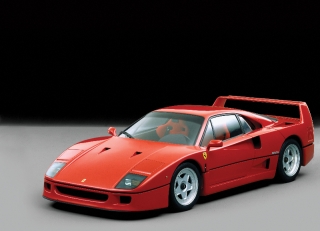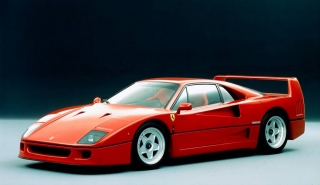« SP12 EC
| General data | |
| Year/s of production | 1987 – 1992 |
| Presentation | Maranello, 21 July 1987 Geneva Motor Show March 1988 – S/N 76354 |
| VIN span | 76624 – 95317 + approx. 7 prototypes |
| Number produced | Approx. 1311 |
| Design | Pininfarina |
| Manufactured by | Scaglietti – Ferrari S.p.A. |
| Technical specifications | |
| Chassis | F 120 AB 100 – Steel tube frame strengthend with composite material |
| Length | 4430 mm |
| Width | 1980 mm |
| Height | 1130 mm |
| Wheelbase | 2450 mm |
| Front suspension | Independent wheel suspension, double delta wishbones, koaxial coil springs, Koni telescope shock absorbers, anti-roll bar |
| Rear suspension | Independent wheel suspension, double a-arms, koaxial coil springs, Koni telescope shock absorbers, anti-roll bar |
| Front track | 1594 mm |
| Rear track | 1610 mm |
| Front tyres | 8 x 17 in., alloy rims, 5-star design with central locking Tyres: Pirelli P Zero 245/40 ZR 17 |
| Rear tyres | 13 x 17 in., alloy rims, 5-star design with central locking Tyres: Pirelli P Zero 335/35 ZR 17 |
| Front brakes | Brembo ventilated and cross-drilled iron discs, 4-pod aluminium callipers, 330 mm |
| Rear brakes | Brembo ventilated and cross-drilled iron discs, 4-pod aluminium callipers, 330 mm |
| Weight | Approx. 1100 kg |
| Body material | Carbon and Kevlar |
| Body type | Berlinetta – two seats |
| Engine | |
| Type | F 120A and F 120AB – mid-engine – longitudinal installed |
| Number of cylinders | V8 – 90° |
| Displacement | 2936 ccm |
| Turbo | 2 IHI turbocharger, 2 Behr intercooler |
| Charging-air pressure | 1,1 bar, 1 wastegate valve |
| Bore and stroke | 82 x 69,5 mm |
| Camshaft | 2 overhead per cylinder bank |
| Valves | 4 per cylinder |
| Compression ratio | 7,7:1 |
| Ignition | Electronic ignition by Weber Marelli |
| Lubrication | Dry sump lubrication with oil cooler (right oil cooler) |
| Maximum power | 478 hp – 7.000 rpm |
| Maximum torque | 577 Nm – 4.000 rpm |
| Fuel management | Electronic fuel injection by Weber Marelli |
| Clutch | Twin disc dry clutch |
| Gearbox | 5 gears + rev., – longitudinal installed with oil cooler (left oil cooler), limited slip differential |
| Performance | |
| Top speed | 324 km/h |
| 0-200 km/h | 12,0 sec. |
| 0-1000 m | 21,0 sec. |
| VINs | |
| Prototypes: S/N: 73015, 74045, 74047, 74049, 74327, 75034, 75052, 76354 | |
| S/N 74047: Later converted by Michelotto to F 40 GT – Raced in Italian GT Championship | |
| S/N 74045: Later converted to F 40 LM – Le Mans 1995: 12th place, Le Mans 1996: Retired |
Good to know:
|
Ferrari 30th anniversary of the F40
Posted: 21.07.2017 / Source: Ferrari
Maranello, 21 July 2017 – Thirty years have passed since the official presentation of the F40, which took place on 21 July 1987 at the Civic Centre in Maranello, now home to the Ferrari Museum. Created to celebrate the company’s 40th anniversary, it was the last car to carry the founder’s “signature”. It was a definitive car, the ultimate expression of the technology thus far developed by the Prancing Horse, but at the same time it went back to Ferrari’s roots when racing cars were also road vehicles. An extreme derivation of the 308 GTB and of the 288 GTO Evoluzione prototype, the Ferrari F40 is a masterpiece of engineering and style, which entered the collective imagination as a symbol of an era.
On the anniversary of the launch of this motoring legend, Ferrari has gathered together the memories of three of its creators: Ermanno Bonfiglioli, then Head of Special Projects, Leonardo Fioravanti, a designer for Pininfarina, and test driver Dario Benuzzi.
Ermanno Bonfiglioli, who as Head of Special Projects was responsible for supercharged engines, has not forgotten the excitement of that 21 July: “I have never experienced a presentation like that of the F40. When the car was unveiled, a buzz passed through the room followed by thunderous applause. No one, except for close associates of Enzo Ferrari, had yet seen it. Indeed, the company had cloaked the development and testing of that car in unusual secrecy. And the surprise at such a stylistic leap was almost shock. The timeframe was also unusual, within the very short arc of 13 months, the chassis and bodywork moving ahead quickly and at the same pace as the powertrain. It was June 1986 when we began designing the engine of the project F 120 A. The 8-cylinder 478 hp twin-turbo was a derivative of the 288 GTO Evoluzione’s, but a number of innovative contents enabled the F40 to become the first production Ferrari to exceed 320 km/h. We paid maximum attention to the weight of the engine, thanks also to the extensive use of magnesium, such as oil sump, cylinder-head covers, intake manifolds, and gearbox bell-housing were in this material that cost five times as much as aluminium alloy and that was never used in such quantities in subsequent production cars. This is just a small example of this car’s “difference”.
Leonardo Fioravanti was a designer at Pininfarina when he was invited by Enzo Ferrari to Fiorano to try the 288 GTO Evoluzione: “when il Commendatore asked for my opinion on this experimental prototype, which due to regulatory issues never went into production, I didn’t hide my enthusiasm as an amateur driver for the incredible acceleration of its 650 hp. It was then that he first talked to me of his desire to produce a “true Ferrari”. We knew, as he knew, that it would be his last car. We threw ourselves headlong into the work. Extensive research at the wind tunnel went into aerodynamic optimisation, to achieve coefficients appropriate for the most powerful Ferrari road car ever. Its style matches its performance: the low bonnet with a very tiny overhang, the NACA air vents and the rear spoiler, which my colleague Aldo Brovarone placed at right angles, made it famous. If I had to point out one overriding reason for the success of the F40, I would say that its line succeeded in instantly transmitting the exceptionality of its technical content: speed, lightness, and performance.”
Dario Benuzzi, a Ferrari’s long-term test driver, participated in an arduous and meticulous testing job: “The handling of the first prototypes was poor. To tame the power of the engine and make it compatible with a road model, we needed to subject every aspect of the car to countless tests: from the turbochargers to the braking system, from the shock absorbers to the tyres. The result was an excellent aerodynamic load and high stability even at high speed. Another important aspect was the tubular steel frame with Kevlar reinforcement panels, which provides three times more torsional rigidity than that of other cars of the period, and a bodywork made mainly of composite materials that reduced weight to just 1100 kg. We obtained precisely the car we wanted, with few comforts and no compromises. With no power steering, power brakes or electronic devices, it demands the skill and commitment of the driver but generously repays it with a unique driving experience. Steering precision, road holding, braking power and intensity of acceleration reached unmatched levels for a road car.
The F40 – still a winner
Posted: 09.04.2013
Source: Ferrari
Maranello, 9th April – The F40, the last car launched by Enzo Ferrari before his death, received a major new plaudit this afternoon, a good 25 years after its debut as more than 20,000 readers of the highly-respected German car magazine, Motor Klassik, voted it Classic Car of 2013 in the 1980-1991 category.The award was presented to Stefan Müller, head of Ferrari Central/East Europe, at a ceremony held at Schloss Dyck Castle in North Rhine-Westphalia. “This award is a great honour for us because the F40 was a unique car that epitomised the Ferrari supercar myth in the 1980s,” declared Müller. “It became an object of desire for collectors across the globe, and, to this day, enthusiasts and experts the world over regard it as one of the great iconic models in our history.”The F40 took over the baton from the GTO, the first of the limited edition supercars whose ranks were recently swelled by the new LaFerrari. A total of 1,315 were built. Enthusiasts of all kinds can currently enjoy a first-hand experience of the Prancing Horse’s supercar history at the Ferrari Museum in Maranello. The latter’s special “Ferrari Supercar. Technology. Design. Myth” exhibition features not just the GTO, the F40 and the LaFerrari but also the F50 and the Enzo, all protagonists in an extraordinary chapter in the Prancing Horse’s history.
















